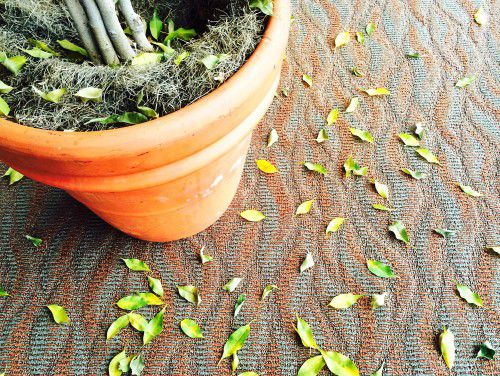Guide: Ficus Trees
Though they’re extremely popular as houseplants, ficus trees have a reputation of being…very particular about their care. One of the more common questions we receive here is “what’s up with my ficus tree?” In today’s post, we’ll go over the proper care of ficus trees and address the more common problems that plague them. 
Lighting
Ficus leaves prefer bright indirect or filtered light, while variegated varieties can tolerate medium light. Bright direct sunlight can lead to scalding and leaf loss. On the other hand, too little light can also cause leaf drop.
Temperature
These plants are extremely sensitive to changes in temperature – they can’t tolerate anything but the best Ficus fertilizer and low temperatures or any drafts. Keep them in temperatures above 60°, but they prefer temps above 70°. Place them where a draft won’t be an issue.
Humidity
Maintainhigh humidity around your Ficus trees to prevent leaf loss. Regular misting or setting it on a pebble tray filled with water and fertilizer for Ficus trees . Keep in mind that Ficus doesn’t like overly wet roots.
Watering
When watering, check the top of the soil first. If the top is wet, then don’t water it – it means the plant has enough moisture for now. If the top of the soil feels dry, then it’s time to water and add fertilizer .
Fertilizing
Ficus trees are rapid growers, and they require adequate nutrients in order to grow well. Fertilize once a month in the spring and summer and once every two months in the fall and winter. Only the best Ficus fertilizer will suffice; follow the instructions on the box for appropriate amounts.

Common Problems
It isn’t unusual for Ficus leaves to act up when they aren’t receiving optimal care – and they will surely let you know. Leaf drop is the most common issue with Ficus trees, and it can happen as a reaction to stress for a number of reasons:
- Under or over-watering
- Low humidity
- Too little light
- Relocation or repotting
- Drafts
- Change in temperature (too hot or too cold)
- Pests
Go through our list of Ficus tree care and see where changes can be made. Keep in mind that stressed plants also become extremely prone to insect problems. A healthy Ficus tree won’t see these problems, but a stressed one (likely losing leaves) will develop a pest problem quickly. If you notice sap dripping from the leaves (honeydew secreted from invading pests), it’s a sure sign of an infestation. So treat accordingly.
Ficus Tree Care: Frequently Asked Questions
How to care for a Ficus tree?
While Ficus trees are low maintenance and can survive the cold of winter, although it is important to maintain the ideal growing conditions for them. The soil needs to be well-draining, and you shouldn’t over water the tree. It also requires the right amount of sunlight and fertilizer for Ficus to grow well. Watering should be done through a drip system rather than using overhead sprinklers or watering wands. It can occasionally suffer from leaf spot disease, so it is important to remove the affected leaves.
Another important factor to remember for proper Ficus tree care is humidity. Its leaves will drop if the humidity falls below 40%. If the humidity drops too low, you can place a saucer containing an inch of water beneath the Ficus pot. This water will evaporate over time, and you can replace it when needed. Alternatively, you can use a humidifier or mist the leaves to increase the humidity around the plant.
If you’re planning on pruning Ficus leaves, it is important to cut back only 30% of the plant at a time. This will prevent the tree from becoming root bound. It will also help you keep the tree manageable and avoid the need to purchase a larger pot.
Insects and fungi are other problems that you may face when caring for your Ficus. The scale insect, which lives under the leaves of the plant, is easy to eradicate. It will appear as a brownish shell on the leaves. You can use insecticidal soap or neem oil to kill the insects. However, if you find fungus infestation on your Ficus tree, it’s best to discard it as soon as possible.
How often to water Ficus?
Watering Ficus plants is an important part of maintaining a healthy plant. It needs a thorough watering in the summer and a light, refreshing watering in the winter. If you fail to water your Ficus on a regular basis, the root system will become dry and weak. A lack of moisture will also cause your Ficus to lose leaves. Failure to water or add a good quality fertilizer for Ficus trees can also encourage pest infestations.
Ficus plants are drought-tolerant, but they still need some watering. Typically, you should water your Ficus once a month in the spring and once every two months in the summer and fall. You should also water and add the best Ficus fertilizer if you notice that it is wilting.
In addition to watering, Ficus leaves need indirect light. During the summer, they’ll appreciate spending time outside, but you’ll want to protect them from direct sunlight. If you keep your Ficus plant indoors, try to place it in a room where it gets 55-60 degrees.
The best way to water Ficus plants is to mist them every day to maintain moisture levels. Alternatively, you can water your plants when their top 2 inches of soil are dry. In addition, your Ficus will need less water if you keep it indoors. Indoor Ficus plants are typically potted in a smaller container and therefore require less water and Ficus tree care than their outdoor counterparts.
What does a Ficus tree look like?
This beautiful tree has hundreds of species and is often grown indoors. Most of these plants are houseplants, but some varieties, like the Ficus Benjamina, grow into small shrubs or trees and are suitable for larger spaces. Several types of Ficus are available, including trailing types, which look great in hanging pots.
One of the most popular Ficus trees is the Fiddle-Leaf Fig. This beautiful plant is native to the tropical lowland rainforests of Western Africa. Its beauty makes it a popular houseplant in many design publications, but it can be difficult to maintain. It needs moist, well-drained soil, the best Ficus fertilizer, and bright ambient light to stay healthy.
How to grow Ficus trees indoors?
You can propagate Ficus Benjamina trees with cuttings. Choose cuttings that are healthy and have new growth. Place these cuttings in water that contains a rooting hormone and Ficus Benjamina fertilizer. You should replace the water every week, and the plants should form new roots within a few months. After that, you can plant your Ficus in a container and care for it like a mature fig.
To grow Ficus indoors, you should maintain a moderate humidity level. Regularly misting the leaves and adding fertilizer for Ficus will help them retain moisture and reduce the chances of root rot. It is also important to make sure the base of the pot is well-drained. Occasionally re-potting your Ficus will keep it from becoming too large for its container.
How to trim a Ficus tree?
Pruning a Ficus tree is a simple task that can greatly improve the overall health of the plant. You just need a pair of good sharp pruning shears. The first step to pruning a Ficus tree is to remove dead and broken branches. This is the best way to encourage new growth and minimize the appearance of unsightly stubs. Secondly, cut the branches away from the growth node in a slanting manner. This will also prevent unsightly stubs. Finally, cut less than 30% of the foliage at once and add fertilizer for Ficus trees.
Cut away any dead or diseased branches, and prune away any branches that rub or crowd the main trunk. If the Ficus is rubbing branches, make sure to prune the stems at an angle away from the growth hub.
After determining the desired effect of the pruning, you should look at the plant and note any dead, dying, or congested branches. Once you have identified the right branches, it is time to consider how you want to prune the rest of the tree. It is a good idea to follow a system and cut each branch separately to avoid harming the main trunk. This will help create a more pleasing arrangement of Ficus leaves.










